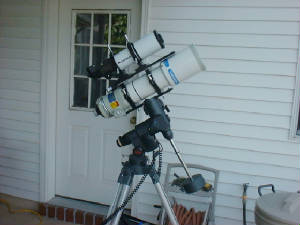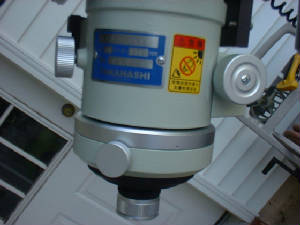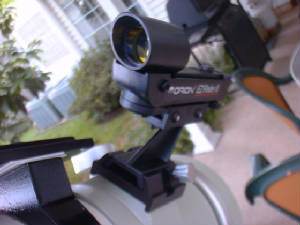|
|
 |
I received the Takahashi FSQ-106N on July 29, 2004. What
a fine scope! Initially I'll be using it as a visual instrument, later as an astrograph. I like this scope too
much to be objective, so be forewarned. Here are my impressions (also see photos below):
-
The contrast at low power exceeds all of my other scopes.
- Lunar viewing: Low power views of the moon in the Tak are extraordinary
but very bright. Lunar views at all magnifications were better than I've ever seen in the 5" scopes (Mak and
achromat). With the Extender-Q and a PowerMate it approaches what the 10" scope can do at high power (I know,
hard to believe). And you don't have to wait for cooldown at all. Lunar features were evident far away from the
terminator, unlike my other scopes.
-
Planets: Venus showed a slight flare when it was low in the sky, but appeared clean later
(not sure why). Uranus was easy, a well-defined disk at 273x. Dim, but nice and steady (actually my best-ever
view). Views of Saturn at high power are remarkably similar to the 10" scope though dimmer. This scope performs
very well on planets but has a wide enough field to frame the Pleaides. Through experience I've learned to optimize
it's performance by keeping the magnification and exit pupil reasonable (about 200x is as high as you really need to go).
-
At my site the heavy sky glow makes low power viewing difficult, but the excellent contrast helps cut
the glow a little. Though faint and fuzzy, I have already seen a few objects for the first time ever at home.
-
I can't see any false color, period. Optical aberrations
I've found so far are minor (due to my eyepieces and my not-so-good vision). What little aberration
there is, it seems to disappear with Extender-Q, since the f/8 ratio is more compatible with normal eyepieces. Even
bright stars tend to be very sharp.
-
The optical coatings are as good as I've ever seen. The
objective lens looks inky black (pictures below are deceiving).
| |
|
|

|
Don't try this at home! The Takahashi FSQ-106N below, an
Orion ST80 above, supported by a Meade LXD55 mount. I later added a second counterweight. The LXD55 is fine
for visual work, but I get guiding errors of 15 arc-seconds or more with my webcam on the ST80. The FSQ is
mounted on a ScopeStuff solid dovetail with Parallax rings, a Losmandy DUP bridge (a bit too long, required shims), and Losmandy
rings for the ST80.
|
|

|
The Meade LXD55 just wasn't up to the task of autoguiding
the FSQ for long exposure astrophotography (no surprise). The new Losmandy G-11 finally arrived, seen here.
It seems rock solid and beautifully crafted, though it hasn't been deployed yet.
Here's a view of the oversized 4" focuser, capable of an 88mm
image circle on film. Though it's very smooth, it might be a little coarse for imaging (a 10:1 micro edge focuser is
available). Also shown is the camera angle adjuster, standard on the FSQ.
|
|
|
Among apochromatic refractors, the FSQ is unique. It's a modified
Petzval design with two doublets (front and rear, each with a fluorite element). The camera picked up a lot of
reflection here, but to the eye you see dark purple to inky black when viewing the objective.
|
|

|
I installed a 1x red-dot finder rather than the much more expensive
Takahashi finderscope. This is an Orion EZ Finder II with Orion's SCT base. With a couple of slightly longer
screws it seemed to fit nicely and doesn't interfere with the guidescope assembly above.
|
Like all fine things, the Tak has a few quirks:
- The fast f/5 focal ratio demands better eyepieces than I currently own. Some sharpness is lost at the edge-of-field
in Plossl eyepieces. This is probably true of any f/5 scope, and the issues go away with the Extender-Q installed
(f/8).
-
In-focus travel is limited. With my 1.25" mirror
diagonal I could not reach focus. Prism diagonals work fine; mine doesn't seem to introduce chromatic effects even
at this low f-ratio. After further review I've determined that my nearsightedness makes this problem worse. With
the Extender-Q in place the in-focus problem goes away just barely, but you can play games with the spacers if you need to.
-
The scope is solid as a rock, and it's as heavy as everyone
says. It's a bit of a shock when you hoist it. But if you're used to a 60 lb. SCT, it's a piece of cake.
Though it's not suited for long-exposure imaging, the Meade LXD55 is adequate for visual work and lunar imaging.
Soon I hope to shoot deep sky images with the new Losmandy G-11 mount. Stay tuned.
|
 |
|
|
|
|
|
 |

